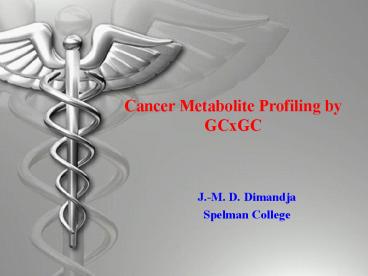Cancer Metabolite Profiling by GCxGC - PowerPoint PPT Presentation
Title:
Cancer Metabolite Profiling by GCxGC
Description:
Citric acid. Urinary Profile (Diseased State) Hippuric acid. trans-Aconitic acid ... Citric acid. Profile Comparison. Similarity Index: 628. Conventional ... – PowerPoint PPT presentation
Number of Views:205
Avg rating:3.0/5.0
Title: Cancer Metabolite Profiling by GCxGC
1
Cancer Metabolite Profiling by GCxGC
- J.-M. D. Dimandja
- Spelman College
2
Cancer Research Strategies
Preventive
Curative
3
Bio-Metabolic Profiling
First developed by Roger Williams and his
associates in the 1940s (using paper
chromatography)
Examined over 200,000 samples from a variety of
subjects (alcoholics, schizophrenics, etc.) and
produced suggestive evidence of
characteristic metabolic patterns associated with
each of the groups.
Williams, R.J., et al. Individual Metabolic
Patterns and Human Disease An exploratory
Study Utilizing Predominantly Paper
Chromatographic Methods. U. Texas Publication
No. 5109 (1951)
4
Carcinogenesis and Metabolic Profiling
- Carcinogenesis is known to affect a complex
network of metabolic interrelationships, leading
to significant changes in concentration of a
large number of body fluids.
5
Organic Acids
- Organic acids are well established as important
biochemical indicators of abnormal metabolism
created by various diseases.
6
Goals of Metabolic Profiling
- Characterization of normal and pathologic states
- Studies of drug metabolism
- Human developmental studies
Horning, E.C., Horning, M.G. Metabolic Profiles
Gas-Phase Methods for Analysis of Metabolites.
Clin. Chem. 17, 802 (1971)
7
Challenges of Metabolic Profiling
- Number of samples to analyze (for proper
statistical treatment of the data) - Sample complexity
- Sample preparation
- Sample separation
- Data processing
8
Starting Point
9
Sample Preparation
SPE
SPE
Methoximation
Acidification
pH 13
pH 2
Silylation
12 Hours
GC/MS
K.-R. Kim et al. Gas Chromatographic Profiling
and Pattern Recognition Analysis of Urinary
Organic Acids from Uterine Myoma Patients and
Cervical Cancer Patients. J. Chrom. B, 712
(1998), 11-22.
10
Sample Separation
11
Data Processing
12
(No Transcript)
13
Challenges of the Kim Method
Sample Preparation
Sample Separation
Data Processing
14
Goal of our Laboratory
Impact Higher Throughput
Sample Preparation
Sample Separation
Data Processing
15
Sample Preparation
16
pH Reduction
17
Acidified Sample
18
Dichloromethane Addition
19
Liquid/Liquid Extraction
20
Liquid-Liquid Extraction
21
Filtration
Aqueous removal
Sodium Sulfate
Drying
2 Hours
Silylation in Pyridine
GCxGC
22
GCxGC Instrumental Conditions
- Pegasus 4D (LECO Corporation, St. Joseph, MI)
- Sample Inlet
- 1 uL injection, splitless
- Helium carrier gas (1 mL/min)
- 1st Dimension Column
- 30 m Rtx-1 column (Restek Corporation,
Bellefonte, PA), 0.25 mm i.d., 0.25 um film - 40C to 280C (5C/min), 12 min hold at 280C
- Modulator
- 4-second modulation
- 80 msec release time
- 70C to 310C (5C/min), 12 min hold at 310C
- 2nd Dimension Column
- 1.5 m Rtx-50 column, 0.25 mm i.d., 0.25 um film
- 45C to 285C (5C/min), 12 min hold at 285C
- TOF MS
- 100 scans/sec acquisition (30 - 500 amu)
- Ion source temperature 200C
- Transfer Line temperature 285C
- FID
23
(No Transcript)
24
GCxGC Peak Apex Plot
25
Data Processing
- Extract a pattern out of a profile
- Compare profiles
- Similarity indexing
26
Urinary Sample Comparisons
- Similarity Index scale
- Similar to library searching in Mass Spectrometry
- Calculation of residual error
- 1st dimension retention
- 2nd dimension retention
- Normalized relative peak area
27
Urinary Profile (Non-Diseased State)
Hippuric acid
trans-Aconitic acid
2-Hydroxybutyric acid
Pyruvic acid
Citric acid
28
Urinary Profile (Diseased State)
Hippuric acid
2-Hydroxybutyric acid
trans-Aconitic acid
Pyruvic acid
Citric acid
29
Profile Comparison
Similarity Index 628
30
Conventional Chromatography
Sample Inlet
Sample Detection
Sample Separation
31
Alphabetography
Name mixture
Letter Sorter
Alphabet Signal Profile
32
Stephen Reichenbach
h
c
i
b
e
n
e
a
h
h
t
R
c
e
a
b
c
d
e
f
g
h
i
j
k
l
m
n
o
p
q
r
s
t
u
v
w
x
y
z
p
S
e
n
33
a
b
c
d
e
f
g
h
i
j
k
l
m
n
o
p
q
r
s
t
u
v
w
x
y
z
34
a
b
c
d
e
f
g
h
i
j
k
l
m
n
o
p
q
r
s
t
u
v
w
x
y
z
35
(No Transcript)
36
(No Transcript)
37
Similarity Matching Table for Steve Reichenbach
1000
692
692
683
635
38
Similarity Matching Table for John Dimandja
1000
660
654
558
532
39
(No Transcript)
40
Last Name
First Name
41
John Seeley
John Dimandja
1D similarity Index 654
2D first name similarity Index 1000 2D second
name similarity index 654
42
Aromatics
Dicarboxylic Acids
Malic
Citric
Citramalic
Tricarboxylic Acids
Monocarboxylic Acids
43
Multi Level Similarity Indexing
429
960
340
44
Conclusions
- Multidimensional profiling method has been
demonstrated for selected organic acid standards
more standards need to be added to improve the
screening process. - GCxGC allows for high-throughput sample
preparation strategies - GCxGC-MS is indispensable for method development
GCxGC-FID can be used for routine analysis - Advanced chemometric methods need to be further
developed for effective data processing
45
Acknowledgements
- LECO Corporation
- Restek Corporation
- NSF/SEI Grant
- Ms. Deanna J. Scott
- Ms. Isioma Enwerem
- Ms. Courtnea Rainey































